Eclipse season
An eclipse season is one of only two periods during each year when eclipses can occur, due to the variation in the orbital inclination of the Moon. Each season lasts about 35 days and repeats just short of six months later, thus two full eclipse seasons always occur each year. Either two or three eclipses happen each eclipse season. During the eclipse season, the inclination of the Moon's orbit is low, hence the Sun, Moon, and Earth become aligned straight enough (in syzygy) for an eclipse to occur.
Eclipse seasons should occur 38 times within a saros period (6585.3 days).
The type of each solar eclipse (whether total or annular, as seen from the sublunar point) depends on the apparent sizes of the Sun and Moon, which are functions of the distances of Earth from the Sun and of the Moon from Earth, respectively, as seen from Earth's surface. These distances vary because both the Earth and the Moon have elliptic orbits.
If the Earth had a perfectly circular orbit centered around the Sun, and the Moon's orbit was also perfectly circular and centered around the Earth, and both orbits were coplanar (on the same plane) with each other, then two eclipses would happen every lunar month (29.53 days). A lunar eclipse would occur at every full moon, a solar eclipse every new moon, and all solar eclipses would be the same type.
Details
An eclipse season is the only time when the Sun (from the perspective of the Earth) is close enough to one of the Moon's nodes to allow an eclipse to occur. During the season, whenever there is a full moon a lunar eclipse will occur and whenever there is a new moon a solar eclipse will occur. If the Sun is close enough to a node, then a total eclipse will occur. Each season lasts from 31 to 37 days, and seasons recur about every 6 months. At least two (one solar and one lunar, in any order), and at most three eclipses (solar, lunar, then solar again, or vice versa), will occur during every eclipse season. This is because it is about 15 days (a fortnight) between full moon and new moon and vice versa. If there is an eclipse at the very beginning of the season, then there is enough time (30 days) for two more eclipses.
In other words, because the eclipse season (34 days long on average) is longer than the synodic month (one lunation, or the time for the Moon to return to a particular phase and about 29.5 days), the Moon will be new or full at least two, and up to three, times during the season. Eclipse seasons occur slightly shy of six months apart (successively occurring every 173.31 days - half of an eclipse year), the time it takes the Sun to travel from one node to the next along the ecliptic. If the last eclipse of an eclipse season occurs at the very beginning of a calendar year, it is possible for a total of seven eclipses to occur since there is still time before the end of the calendar year for two full eclipse seasons, each having up to three eclipses.[1][2][3]
Examples: Part 1 out of 4
Visual sequence of two particular eclipse seasons
In each sequence below, each eclipse is separated by a fortnight. The first and last eclipse in each sequence is separated by one synodic month. See also Eclipse cycles.
| June 5th Descending node (full moon) | June 21st Ascending node (new moon) | July 5th Descending node (full moon) |
|---|---|---|
 |  | 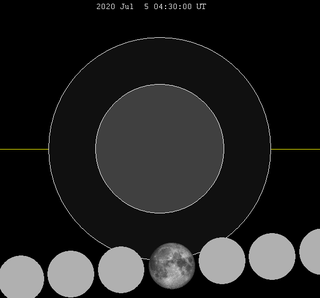 |
| Penumbral lunar eclipse Lunar saros 111 |
Annular solar eclipse Solar saros 137 |
Penumbral lunar eclipse Lunar saros 149 |
| June 12th Descending node (new moon) | June 26th Ascending node (full moon) | July 11th Descending node (new moon) |
|---|---|---|
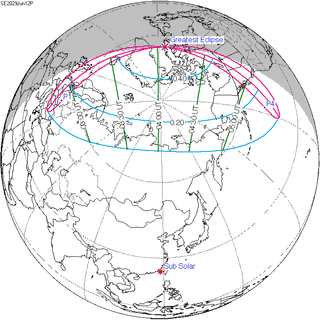 |  | 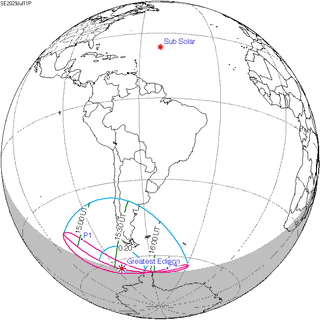 |
| Partial solar eclipse Solar saros 118 |
Total lunar eclipse Lunar saros 130 |
Partial solar eclipse Solar saros 156 |
(The two eclipse seasons above share similarities (lunar or solar centrality and gamma of each eclipse in the same column) because they are a half saros apart.)[4]
15-year chart of eclipses (2004–2018) demonstrating seasons
| Date | Type (phase) | Time of season | Saros series | next eclipse will occur... |
|---|---|---|---|---|
| April 19, 2004 | solar (new) | beginning | Solar saros 119 (65 of 71) | next full moon |
| May 4, 2004 | lunar (full) | end | Lunar saros 131 (33 of 72) | next eclipse season |
| ... no eclipses for about 5 and a half months... | ||||
| October 14, 2004 | solar (new) | beginning | Solar saros 124 (54 of 73) | next full moon |
| October 28, 2004 | lunar (full) | end | Lunar saros 136 (19 of 72) | next eclipse season |
| ... no eclipses for about 5 and a half months... | ||||
| April 8, 2005 | solar (new) | beginning | Solar saros 129 (51 of 80) | next full moon |
| April 24, 2005 | lunar (full) | end | Lunar saros 141 (23 of 72) | next eclipse season |
| ... no eclipses for about 5 and a half months... | ||||
| October 3, 2005 | solar (new) | beginning | Solar saros 134 (43 of 71) | next full moon |
| October 17, 2005 | lunar (full) | end | Lunar saros 146 (10 of 72) | next eclipse season |
| ... no eclipses for about 5 months... | ||||
| March 14, 2006 | lunar (full) | beginning | Lunar saros 113 (63 of 71) | next new moon |
| March 29, 2006 | solar (new) | end | Solar saros 139 (29 of 71) | next eclipse season |
| ... no eclipses for about 5 and a half months... | ||||
| September 7, 2006 | lunar (full) | beginning | Lunar saros 118 (51 of 73) | next new moon |
| September 22, 2006 | solar (new) | end | Solar saros 144 (16 of 70) | next eclipse season |
| ... no eclipses for about 5 and a half months... | ||||
| March 3, 2007 | lunar (full) | beginning | Lunar saros 123 (52 of 72) | next new moon |
| March 19, 2007 | solar (new) | end | Solar saros 149 (20 of 71) | next eclipse season |
| ... no eclipses for about 5 and a half months... | ||||
| August 28, 2007 | lunar (full) | beginning | Lunar saros 128 (40 of 71) | next new moon |
| September 11, 2007 | solar (new) | end | Solar saros 154 (6 of 71) | next eclipse season |
| ... no eclipses for about 5 months... | ||||
| February 7, 2008 | solar (new) | beginning | Solar saros 121 (60 of 71) | next full moon |
| February 21, 2008 | lunar (full) | end | Lunar saros 133 (26 of 71) | next eclipse season |
| ... no eclipses for about 5 and a half months... | ||||
| August 1, 2008 | solar (new) | beginning | Solar saros 126 (47 of 72) | next full moon |
| August 16, 2008 | lunar (full) | end | Lunar saros 138 (28 of 82) | next eclipse season |
| ... no eclipses for about 5 and a half months... | ||||
| January 26, 2009 | solar (new) | beginning | Solar saros 131 (50 of 70) | next full moon |
| February 9, 2009 | lunar (full) | end | Lunar saros 143 (17 of 72) | next eclipse season |
| ... no eclipses for about 5 months... | ||||
| July 7, 2009 | lunar (full) | beginning | Lunar saros 110 (71 of 72) | next new moon |
| July 22, 2009 | solar (new) | middle | Solar saros 136 (37 of 71) | next full moon |
| August 6, 2009 | lunar (full) | end | Lunar saros 148 (3 of 70) | next eclipse season |
| ... no eclipses for about 5 months... | ||||
| December 31, 2009 | lunar (full) | beginning | Lunar saros 115 (57 of 72) | next new moon |
| January 15, 2010 | solar (new) | end | Solar saros 141 (23 of 70) | next eclipse season |
| ... no eclipses for about 5 and a half months... | ||||
| June 26, 2010 | lunar (full) | beginning | Lunar saros 120 (57 of 83) | next new moon |
| July 11, 2010 | solar (new) | end | Solar saros 146 (27 of 76) | next eclipse season |
| ... no eclipses for about 5 and a half months... | ||||
| December 21, 2010 | lunar (full) | beginning | Lunar saros 125 (48 of 72) | next new moon |
| January 4, 2011 | solar (new) | end | Solar saros 151 (14 of 72) | next eclipse season |
| ... no eclipses for about 5 months... | ||||
| June 1, 2011 | solar (new) | beginning | Solar saros 118 (68 of 72) | next full moon |
| June 15, 2011 | lunar (full) | middle | Lunar saros 130 (34 of 71) | next new moon |
| July 1, 2011 | solar (new) | end | Solar saros 156 (1 of 69) | next eclipse season |
| ... no eclipses for about 5 months... | ||||
| November 25, 2011 | solar (new) | beginning | Solar saros 123 (53 of 70) | next full moon |
| December 10, 2011 | lunar (full) | end | Lunar saros 135 (23 of 71) | next eclipse season |
| ... no eclipses for about 5 and a half months... | ||||
| May 20, 2012 | solar (new) | beginning | Solar saros 128 (58 of 73) | next full moon |
| June 4, 2012 | lunar (full) | end | Lunar saros 140 (24 of 77) | next eclipse season |
| ... no eclipses for about 5 and a half months... | ||||
| November 13, 2012 | solar (new) | beginning | Solar saros 133 (45 of 72) | next full moon |
| November 28, 2012 | lunar (full) | end | Lunar saros 145 (11 of 71) | next eclipse season |
| ... no eclipses for about 5 months... | ||||
| April 25, 2013 | lunar (full) | beginning | Lunar saros 112 (65 of 72) | next new moon |
| May 10, 2013 | solar (new) | middle | Solar saros 138 (31 of 70) | next full moon |
| May 25, 2013 | lunar (full) | end | Lunar saros 150 (1 of 71) | next eclipse season |
| ... no eclipses for about 5 months... | ||||
| October 18, 2013 | lunar (full) | beginning | Lunar saros 117 (52 of 71) | next new moon |
| November 3, 2013 | solar (new) | end | Solar saros 143 (23 of 72) | next eclipse season |
| ... no eclipses for about 5 and a half months... | ||||
| April 15, 2014 | lunar (full) | beginning | Lunar saros 122 (56 of 74) | next new moon |
| April 29, 2014 | solar (new) | end | Solar saros 148 (21 of 75) | next eclipse season |
| ... no eclipses for about 5 and a half months... | ||||
| October 8, 2014 | lunar (full) | beginning | Lunar saros 127 (42 of 72) | next new moon |
| October 23, 2014 | solar (new) | end | Solar saros 153 (9 of 70) | next eclipse season |
| ... no eclipses for about 5 months... | ||||
| March 20, 2015 | solar (new) | beginning | Solar saros 120 (61 of 71) | next full moon |
| April 4, 2015 | lunar (full) | end | Lunar saros 132 (30 of 71) | next eclipse season |
| ... no eclipses for about 5 and a half months... | ||||
| September 13, 2015 | solar (new) | beginning | Solar saros 125 (54 of 73) | next full moon |
| September 28, 2015 | lunar (full) | end | Lunar saros 137 (26 of 78) | next eclipse season |
| ... no eclipses for about 5 and a half months... | ||||
| March 9, 2016 | solar (new) | beginning | Solar saros 130 (52 of 73) | next full moon |
| March 23, 2016 | lunar (full) | end | Lunar saros 142 (18 of 73) | next eclipse season |
| ... no eclipses for about 5 and a half months... | ||||
| September 1, 2016 | solar (new) | beginning | Solar saros 135 (39 of 71) | next full moon |
| September 16, 2016 | lunar (full) | end | Lunar saros 147 (8 of 70) | next eclipse season |
| ... no eclipses for about 5 months... | ||||
| February 11, 2017 | lunar (full) | beginning | Lunar saros 114 (59 of 71) | next new moon |
| February 26, 2017 | solar (new) | end | Solar saros 140 (29 of 71) | next eclipse season |
| ... no eclipses for about 5 and a half months... | ||||
| August 7, 2017 | lunar (full) | beginning | Lunar saros 119 (61 of 82) | next new moon |
| August 21, 2017 | solar (new) | end | Solar saros 145 (22 of 77) | next eclipse season |
| ... no eclipses for about 5 and a half months... | ||||
| January 31, 2018 | lunar (full) | beginning | Lunar saros 124 (49 of 73) | next new moon |
| February 15, 2018 | solar (new) | end | Solar saros 150 (17 of 71) | next eclipse season |
| ... no eclipses for about 5 months... | ||||
| July 13, 2018 | solar (new) | beginning | Solar saros 117 (69 of 71) | next full moon |
| July 27, 2018 | lunar (full) | middle | Lunar saros 129 (38 of 71) | next new moon |
| August 11, 2018 | solar (new) | end | Solar saros 155 (6 of 71) | next eclipse season |
The partial lunar eclipse of August 7–8, 2017 was followed by the solar eclipse of August 21, 2017.
Examples: Part 2 out of 4
Visual sequence of two particular eclipse seasons
In each sequence below, each eclipse is separated by a fortnight. The first and last eclipse in each sequence is separated by one synodic month. See also Eclipse cycles.
| July 7th Ascending node (full moon) | July 22nd Descending node (new moon) | August 6th Ascending node (full moon) |
|---|---|---|
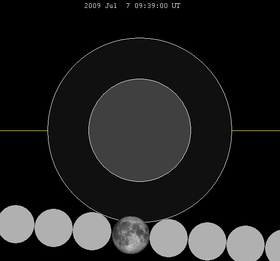 | 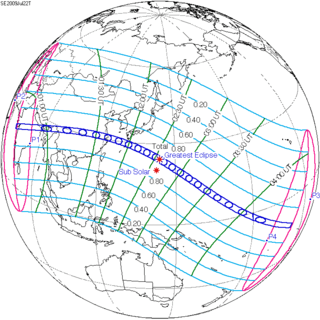 | 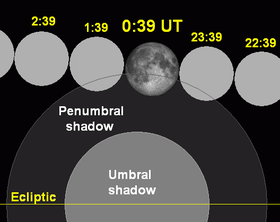 |
| Penumbral lunar eclipse Lunar saros 110 |
Total solar eclipse Solar saros 136 |
Penumbral lunar eclipse Lunar saros 148 |
| July 13th Ascending node (new moon) | July 27th Descending node (full moon) | August 11th Ascending node (new moon) |
|---|---|---|
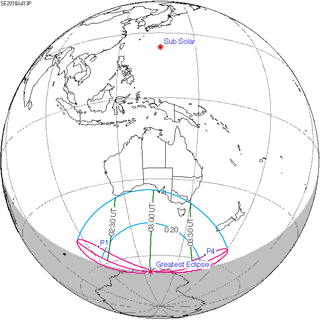 | 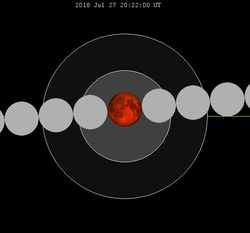 | 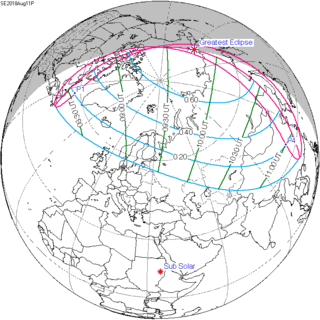 |
| Partial solar eclipse Solar saros 117 |
Total lunar eclipse Lunar saros 129 |
Partial solar eclipse Solar saros 155 |
(The two eclipse seasons above share similarities (lunar or solar centrality and gamma of each eclipse in the same column) because they are a half saros apart.)[4]
Examples: Part 3 out of 4
Visual sequence of two particular eclipse seasons
In each sequence below, each eclipse is separated by a fortnight. The first and last eclipse in each sequence is separated by one synodic month. See also Eclipse cycles.
| July 6th Descending node (full moon) | July 20th Ascending node (new moon) | August 4th Descending node (full moon) |
|---|---|---|
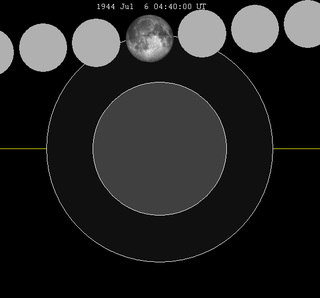 | 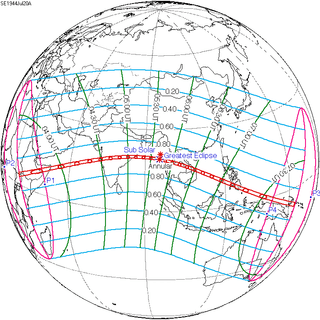 | 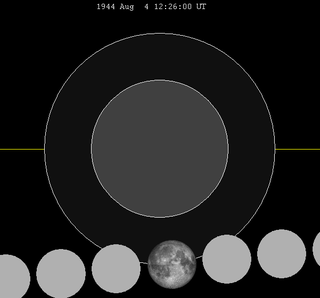 |
| Penumbral lunar eclipse Lunar saros 109 |
Annular solar eclipse Solar saros 135 |
Penumbral lunar eclipse Lunar saros 147 |
| July 11th Descending node (new moon) | July 26th Ascending node (full moon) | August 9th Descending node (new moon) |
|---|---|---|
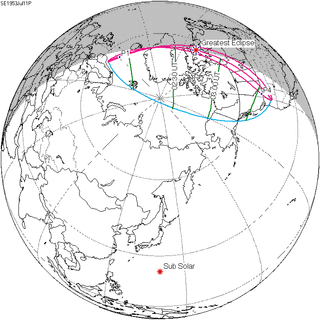 | 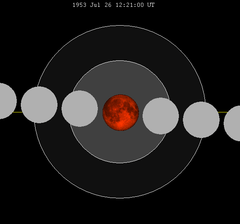 | 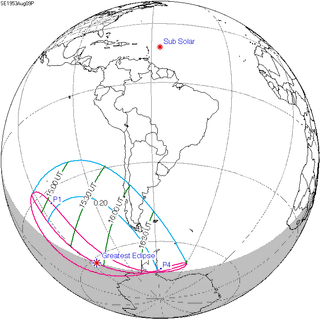 |
| Partial solar eclipse Solar saros 116 |
Total lunar eclipse Lunar saros 128 |
Partial solar eclipse Solar saros 154 |
(The two eclipse seasons above share similarities (lunar or solar centrality and gamma of each eclipse in the same column) because they are a half saros apart.)[4]
Examples: Part 4 out of 4
Visual sequence of two particular eclipse seasons
In each sequence below, each eclipse is separated by a fortnight. The first and last eclipse in each sequence is separated by one synodic month. See also Eclipse cycles.
| July 21st Ascending node (new moon) | August 4th Descending node (full moon) | August 20th Ascending node (new moon) |
|---|---|---|
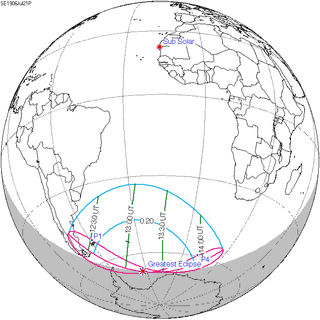 | 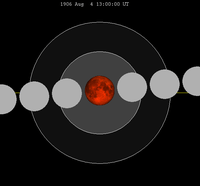 | 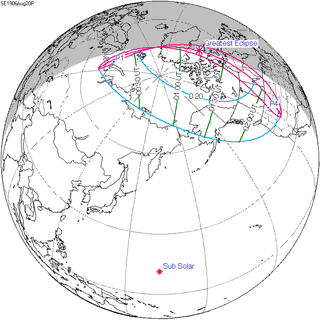 |
| Partial solar eclipse Solar saros 115 |
Total lunar eclipse Lunar saros 127 |
Partial solar eclipse Solar saros 153 |
| July 26th Ascending node (full moon) | August 10th Descending node (new moon) | August 24th Ascending node (full moon) |
|---|---|---|
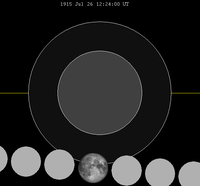 | 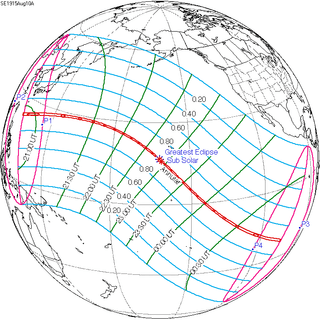 |  |
| Penumbral lunar eclipse Lunar saros 108 |
Annular solar eclipse Solar saros 134 |
Penumbral lunar eclipse Lunar saros 146 |
(The two eclipse seasons above share similarities (lunar or solar centrality and gamma of each eclipse in the same column) because they are a half saros apart.)[4]
References
- Littmann, Mark; Fred Espenak; Ken Willcox (2008). Totality: Eclipses of the Sun. Oxford University Press. pp. 18–19. ISBN 0-19-953209-5.
- Periodicity of Lunar and Solar Eclipses, Fred Espenak
- Five Millennium Catalog of Lunar and Solar Eclipses: -1999 to +3000, Fred Espenak and Jean Meeus
- A Catalogue of Eclipse Cycles, Robert Harry van Gent